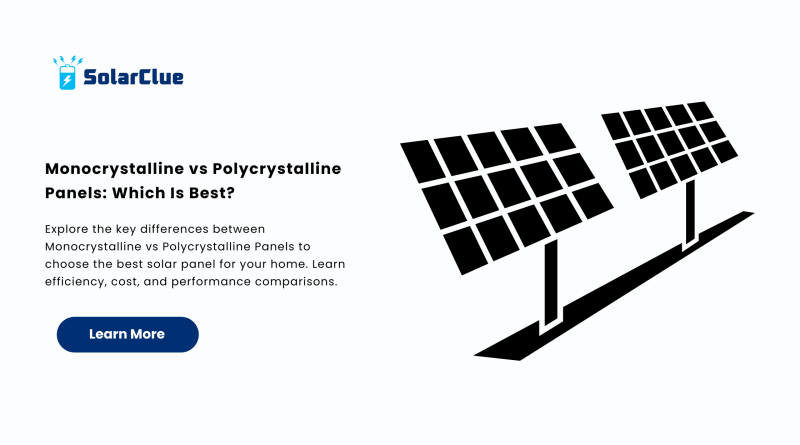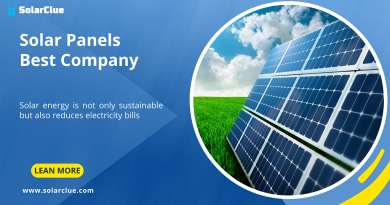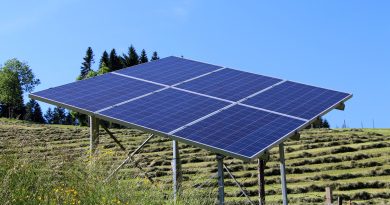Monocrystalline vs Polycrystalline Panels: Which Is Best?
When choosing the best solar panel for home, most homeowners and businesses find themselves debating between Monocrystalline vs Polycrystalline Panels. Both types play a pivotal role in today’s solar power system setups, but they differ in key ways that affect cost, efficiency, aesthetics, and long-term value. This guide dives deep into these differences so you can make an informed decision about your solar panel investment.
Table of Contents
- 1 What Are Monocrystalline Panels?
- 2 What Are Polycrystalline Panels?
- 3 Key Differences: Monocrystalline vs Polycrystalline Panels
- 4 Which Type Lasts Longer?
- 5 Environmental Impact
- 6 Installation Considerations
- 7 Energy Output Comparison
- 8 Cost vs. Value: A Long-Term Outlook
- 9 Real-World Examples
- 10 Which Panel Type Is Best for Indian Homes?
- 11 Future Trends in Solar Panel Technology
- 12 Final Verdict: Which Should You Choose?
- 13 FAQs
What Are Monocrystalline Panels?
Definition and Structure
Monocrystalline panels are made from a single, pure silicon crystal. These panels have a sleek black appearance and are known for their high efficiency rates. The silicon is cut into wafers and shaped into solar cells, which are then assembled into a panel.
Benefits of Monocrystalline Panels
- Higher efficiency (15-22%)
- Longer lifespan (up to 25-30 years)
- Performs better in low-light conditions
- Smaller footprint due to higher output
Ideal Use Cases
Monocrystalline panels are ideal for homes with limited roof space or where aesthetic appeal matters. They are considered the best solar panel option when performance is a top priority.
What Are Polycrystalline Panels?
Definition and Structure
Polycrystalline Panels are created by melting multiple silicon fragments together. This process is less wasteful and more cost-effective, resulting in a bluish hue with a speckled look.
Benefits of Polycrystalline Panels
- Lower manufacturing cost
- Environmentally friendly production
- Ideal for warmer climates
Ideal Use Cases
These panels are suited for homeowners with ample roof space who prioritize budget over maximum efficiency. They still offer excellent performance as part of a solar power system.
Key Differences: Monocrystalline vs Polycrystalline Panels
Efficiency
- Monocrystalline panels: 15-22%
- Polycrystalline Panels: 13-17%
Cost
- Monocrystalline: Higher upfront cost
- Polycrystalline: More budget-friendly
Space Requirements
- Monocrystalline: Requires less space
- Polycrystalline: Needs more surface area for the same output
Appearance
- Monocrystalline: Uniform black, sleek design
- Polycrystalline: Bluish, mosaic look
Performance in High Heat
- Monocrystalline: Performs slightly better
- Polycrystalline: Slightly less efficient in hot conditions
Which Type Lasts Longer?
While both types have warranties ranging between 25-30 years, Monocrystalline panels tend to maintain their efficiency longer. This makes them a solid choice for homeowners seeking long-term value in their solar panel installation.
Environmental Impact
Polycrystalline Panels have a more eco-friendly production process due to reduced silicon waste. However, Monocrystalline panels offer better energy output per square meter, which could offset the initial environmental cost over time.
Installation Considerations
When choosing the best solar panel for home, consider your roof orientation, space availability, and local weather conditions. Monocrystalline panels work better in shaded areas and on smaller roofs. Polycrystalline Panels can be more effective in larger spaces with full sunlight.
Energy Output Comparison
On average, a 300W Monocrystalline panel will produce more electricity than a 300W Polycrystalline Panel due to higher conversion efficiency.
Cost vs. Value: A Long-Term Outlook
While Monocrystalline panels are costlier upfront, their efficiency and longevity can result in better savings over time. Polycrystalline Panels, although cheaper, may require more panels and space, affecting overall costs.
Real-World Examples
In a side-by-side comparison in a sunny region like Rajasthan, Monocrystalline panels produced 20% more energy over a year than Polycrystalline Panels. However, the total cost was 18% higher initially.
Which Panel Type Is Best for Indian Homes?
Given the varying weather conditions across India, Monocrystalline panels are becoming more popular due to their consistent performance. That said, if you have more roof space and budget constraints, Polycrystalline Panels still offer a reliable alternative.
Future Trends in Solar Panel Technology
The future leans toward high-efficiency, low-cost Monocrystalline panels thanks to advancements in PERC and bifacial technology. However, Polycrystalline Panels remain relevant for entry-level users and government-backed projects.
Final Verdict: Which Should You Choose?
If efficiency, aesthetics, and space-saving are top priorities, go with Monocrystalline panels. For those on a budget with ample installation space, Polycrystalline Panels are a practical option.
FAQs
1. Which is more efficient: Monocrystalline vs Polycrystalline Panels?
Monocrystalline panels are more efficient, typically between 15-22%, compared to 13-17% for Polycrystalline Panels.
2. Are Monocrystalline panels worth the extra cost?
Yes, especially for homes with limited roof space or those prioritizing long-term savings and performance.
3. Do both types last the same amount of time?
Generally, yes. Both come with warranties ranging from 25 to 30 years.
4. Which panel performs better in low light?
Monocrystalline panels perform better in low-light and cloudy conditions.
5. What is the best solar panel for home use?
It depends on your needs. For high efficiency and aesthetics, choose Monocrystalline panels. For budget-friendly and decent performance, go with Polycrystalline Panels.
To explore more about solar solutions tailored for you, visit our partner portal solarclue.com or read more expert insights at blog.solarclue.com. Your solar journey starts now!




